What Future is Energy Preparing For?
Major decisions hang in the balance in 2024
Hanford is a special place
For time immemorial, Tribal people have relied on the land, River, and resources in the area now occupied by the Hanford Nuclear Site. Today, Hanford’s resources sustain the region—50 miles of free-flowing water for salmon, drinking water for the city of Richland, water for irrigation, and habitat for elk, sturgeon, eagles, rare plants, and many other birds, fish, and wildlife. The Hanford Reach provides the best mainstream spawning habitat for Chinook salmon in the entire region. The Columbia River is the lifeblood of the region, and the Hanford Reach is the beating heart of that life.

For decades, Tribes have advocated for restoration and protection of this incredible part of the Columbia River Basin. Watchdogs like Columbia Riverkeeper have also played an important role in educating the public about the importance of Hanford.
Hanford remains polluted by contamination from plutonium production
Hanford remains a major, unresolved nuclear waste catastrophe with unaddressed harms to Tribes and people on the Columbia River. In the Treaties signed in 1855 and after, Tribes reserved the right to use Hanford for a wide variety of purposes. In the 1940s and 1950s, the U.S. government removed Tribes from Hanford to establish nine nuclear reactors, multiple massive plutonium processing plants, and still-leaking high level waste tanks—all used for producing plutonium for the American nuclear arsenal. Over decades, the U.S. government released vast quantities of radioactive and toxic pollution into the Columbia River, the soil, and groundwater, poisoning Hanford.
Despite decades of cleanup, soil and groundwater beneath dozens of square miles of Hanford remains too polluted for people to use. This is a violation of legal commitments made by the U.S. government in the Treaties. Hanford’s pollution impacted many people across the Northwest, causing cancer and other illnesses among workers, downwinders, and people living downriver.
Hanford reactors in the background. (2)
Communities impacted by Hanford’s pollution are now educating themselves, speaking up, and leading new conversations about how to secure a better future for Hanford.
Groundwater pollution threats
From the River’s shoreline to the Central Plateau miles away, dozens of square miles of shrub-steppe habitat sit atop groundwater pollution that exceeds standards for safe use. The federal government prohibits access to Hanford’s shoreline because of radioactive and toxic contamination.
Publicly available information, including government reports and monitoring well data, depict Hanford’s groundwater pollution across the site and along the Columbia River’s shoreline. This information shows radioactive, cancer-causing strontium-90 persisting at extraordinarily high levels near the cocooned N Reactor (for example), very close to the Columbia River. Cancer-causing strontium-90 levels remain over 2,000 times the drinking water standard. Water seeping from the shoreline also exceeds drinking water standards. In late 2023, Energy measured strontium-90 levels hundreds of times above drinking water standards in groundwater sampling sites immediately adjacent to the Columbia River.
People across the region deserve to know that Hanford cleanup is far from complete, and radioactive and toxic contamination persists in soil, groundwater—and it reaches the Columbia River.

Pressure for responsible, transparent clean up continues
In 2023, people connected with Hanford in new ways even as the federal government made troubling new discoveries about deadly contamination close to the Columbia River. The knowledge built and shared will allow more people to advocate for protection of communities that rely on the Columbia River as well as the resources on the Hanford Site, itself.
Highlights from 2023
- Third Hanford Journey Event. In June, people attended the Hanford Journey Event. During the event, nearly 70 Yakama Nation Tribal School and Heritage University students joined staff of Yakama Nation’s Environmental Restoration Waste Management Program (ERWM) on a tour through the Hanford Site. The event confirmed once again the profound connection that Tribal people have with the Hanford Site. The bus tour, led by ERWM for students and Tribal members, was the largest event of its kind ever held for Tribal students at Hanford. Columbia Riverkeeper was honored to help with the event, which garnered national media attention.
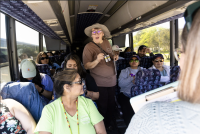
- Surprises at the 324 Building. Throughout 2023, we learned more about one of Hanford’s most dangerous sites, the 324 Building. Located close to Richland and less than 1000 feet from the Columbia River, the building was used to conduct experiments and manipulate high-level nuclear waste. On June 29, 2023, in a nondescript email sent through the Hanford Advisory Board email list, Energy announced a radical proposed change in cleanup at Hanford’s 324 Building. The 324 Building is the same building where workers encountered a startling radioactive surprise—a large amount of highly contaminated soil underneath the building, in an area outside the expected zone. This discovery led to a pause in all structural stabilization efforts at the building while soil sampling and analysis explored the extent of contamination. This sampling revealed a disturbing reality—a new soil hotspot capable of generating a radiation dose of 984 R/hr, very close to the Columbia River. We spent the rest of 2023 questioning whether the contamination is as “stable” as Energy claims, demanding public input on proposed cleanup plan changes to the building, and seeking transparency from the federal government. There was a positive outcome to public pressure: EPA and Energy appear to be preparing to take public input on necessary changes to cleanup plans for the 324 Building.
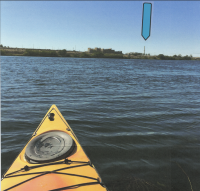
- Public Comments. Thousands of people took action by submitting comments calling on the federal government to fulfill its cleanup obligations. Together we sent a clear message to Congress that Hanford cleanup is a vital, inescapable priority—and Congress allocated a record $3 billion for cleanup. We let the federal government know our clean up priorities at Hanford and as a result saw Energy working steadily towards stabilizing strontium and cesium capsules at the Waste Encapsulation and Storage Facility (WESF) Additionally, although Energy submitted a leak response plan for single-shell tank leaks (really a plan for a plan), there is far more work to be done to prevent tank waste from reaching Hanford soil, groundwater, and the Columbia River.
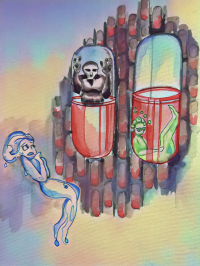
- Legislative Testimony. In October 2023, Columbia Riverkeeper gave testimony (beginning at 29:15) to the Washington state legislature about our concerns at Hanford. Riverkeeper’s testimony offered a blunt reality: pollution from Hanford reaches the River. The resulting questions from legislators inspired Riverkeeper to create a tutorial for our members about how to ground truth pollution impacts at Hanford, explaining where we get our information and how the public can access it. Check out our tutorial on how to use the publicly available PHOENIX website, a partnership between Energy and the Pacific Northwest National Laboratory, which provides real time access to groundwell data across Hanford as well as a vast amount of additional information about contamination at Hanford.
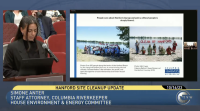
- Small Modular Nuclear Reactors. 2023 also saw Texas-based X-energy announce new plans to consider Hanford for a new nuclear reactor. We have been here before. In 2024, Columbia Riverkeeper will continue to oppose Small Modular Nuclear Reactor development, because adding more nuclear waste to Hanford is a non-starter in our clean energy future.
- Cleanup to Clean Energy Proposal. In late 2023, Energy announced a proposal to lease up to 18,000 acres of Hanford for new energy development, its “cleanup to clean energy” initiative. The controversial proposal could invite new nuclear projects and waste-producing activities at Hanford. The decision could also preclude more important uses of the site to mitigate the harm already caused by the Hanford Nuclear Site’s pollution. You can read Riverkeeper’s comments here. In 2024, there will be a new opportunity to weigh in on this problematic rush to develop land on the Hanford site.
- For all of 2023, the U.S. government and the state of Washington participated in behind-closed-doors talks, deciding the future of Hanford cleanup. These "holistic negotiations" are meant to address the long-term approach to containing and treating tank waste and other issues. We do not know all the issues at stake because the negotiations have been secret. But we believe that there has been extensive debate and negotiation about new tanks to store waste from leak-prone tanks, the use of grout versus glass, and the removal and reclassification of waste remaining in tanks. The results of the holistic negotiations will impact the future of Hanford. Agencies expect that talks will conclude in 2024, and Columbia Riverkeeper plans to engage the public on understanding the results and how we can have a say in our future. For now, let the Tri-Parties know that we want a say in Hanford’s future!
2024: Demanding a cleanup that protects people and the environment
These are a few bottom lines we will work to hold in 2024:
- Energy must address pollution near the Columbia in a way that protects human health and the environment. Cleanup plans should be informed by Tribes’ rights to use Hanford, including areas very close to the Columbia River where Energy plans to impose long-term restrictions. Instead, Energy’s cleanup plans should return the Columbia River to unrestricted use, as much as possible, and work to comply with the federal government's obligations to honor Tribes’ Treaty-reserved rights to use Hanford. Cancer-causing, radioactive, and toxic contamination levels remain very high in some areas close to the River. Energy should avoid downplaying these ongoing problems as it nears final cleanup plans near the K Reactor, N Reactor, and in rethinking the 300 Area cleanup. We will continue to push that reaching final cleanup plans along the River corridor does not mean that cleanup is complete.
- Energy should treat high-level waste as the law requires. This means Energy must treat, immobilize, and remove high-level waste from Hanford. Energy’s proposals to redefine high-level waste, abandon high-level waste in tanks, or use shortcuts that limit short-term costs (such as using unproven grout rather than vitrifying waste into a glass) would prolong and exacerbate risks to groundwater. We will continue to use the “as-good-as-glass” test for any alternative tank waste immobilization technology.
- Energy and Ecology should move swiftly to implement and accelerate efforts to prevent future tank leaks, respond to leaks where they occur, and address tanks that have already failed. Startup of the Waste Treatment Plant took a big step in 2023 with the first successful effort to produce glass from non-radioactive test material, but there were also challenges with tank waste treatment. Washington must hold Energy accountable for the threat posed by high level waste in decades-old tanks. We will continue to push for accountability and funding in this area.
- Energy should move as quickly as possible to remove highly radioactive cesium and strontium capsules from WESF, the highest-risk facility at the Hanford Site. WESF contains tens of millions of curies of radioactivity. If aging water-filled basins that contain the capsules were to fail, cesium and strontium could be released into the environment. WESF should be one of the highest priorities at Hanford. Thanks to public pressure, Energy insists that they are proceeding as quickly as possible. In a meeting in December 2023, Energy expressed confidence that they will begin removing capsules by next year to dry, safer storage. Although this is years behind schedule, it’s a big step forward for reducing risks at Hanford.
- This year, Columbia Riverkeeper will continue to create public spaces to raise awareness about pertinent issues at Hanford, publicize opportunities for public engagement, and highlight victories where our collective voices have made a difference at the Hanford Nuclear Site.
Take Action
Your comments play a significant role in holding the government accountable. Take action today by signing our petition that urges Energy, Ecology, and the EPA to listen to the region’s voice when we say the federal government must fulfill its responsibility to protect the Columbia from 56 million gallons of tank waste, vast quantities of chemical and radioactive contamination in soil and groundwater, and aging, failure-prone tanks and structures.
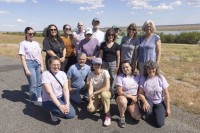
Your comments play a significant role in holding the government accountable. Take action today by signing our petition that urges Energy, Ecology, and the EPA to listen to the region’s voice when we say the federal government must fulfill its responsibility to protect the Columbia from 56 million gallons of tank waste, vast quantities of chemical and radioactive contamination in soil and groundwater, and aging, failure-prone tanks and structures.
This product is funded through a Public Participation Grant from the Washington State Department of Ecology. The content was reviewed for grant consistency but is not necessarily endorsed by the agency.


